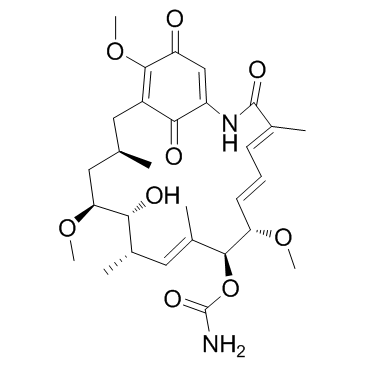Geldanamycin

Geldanamycin structure
|
Common Name | Geldanamycin | ||
|---|---|---|---|---|
| CAS Number | 30562-34-6 | Molecular Weight | 560.636 | |
| Density | 1.2±0.1 g/cm3 | Boiling Point | 783.9±60.0 °C at 760 mmHg | |
| Molecular Formula | C29H40N2O9 | Melting Point | 255 °C | |
| MSDS | Chinese USA | Flash Point | 427.9±32.9 °C | |
|
The induction of heme oxygenase-1 suppresses heat shock protein 90 and the proliferation of human breast cancer cells through its byproduct carbon monoxide.
Toxicol. Appl. Pharmacol. 274(1) , 55-62, (2014) Heme oxygenase (HO)-1 is an oxidative stress-response enzyme which catalyzes the degradation of heme into bilirubin, ferric ion, and carbon monoxide (CO). Induction of HO-1 was reported to have antitumor activity; the inhibitory mechanism, however, is still u... |
|
|
Bioreduction of aryl azides during mutasynthesis of new ansamitocins.
Org. Lett. 15(17) , 4442-5, (2013) Supplementing a culture of a mutant strain of Actinosynnema pretiosum that is unable to biosynthesize aminohydroxy benzoic acid (AHBA), with 3-azido-5-hydroxy-benzoic acid and 3-azido-5-amino-benzoic acid, unexpectedly yielded anilino ansamitocins instead of ... |
|
|
Flotillin depletion affects ErbB protein levels in different human breast cancer cells.
Biochim. Biophys. Acta 1843(9) , 1987-96, (2014) The ErbB3 receptor is an important regulator of cell growth and carcinogenesis. Among breast cancer patients, up to 50-70% have ErbB3 overexpression and 20-30% show overexpressed or amplified ErbB2. ErbB3 has also been implicated in the development of resista... |
|
|
Molecular dissection of the centrosome overduplication pathway in S-phase-arrested cells.
Mol. Cell. Biol. 29(7) , 1760-73, (2009) Cancer cells frequently exhibit overduplicated centrosomes that lead to formation of multipolar spindles, chromosome missegregation, and aneuploidy. However, the molecular events involved in centrosome overduplication remain largely unknown. Experimentally, c... |
|
|
Role of heat shock proteins in oxygen radical-induced gastric apoptosis.
J. Surg. Res. 193(1) , 135-44, (2015) The generation of reactive oxygen species (ROS) and their resultant oxidative damage is a common pathway for gastric mucosal injury. Developing strategies to protect the gastric epithelium against oxygen free radical damage is of profound pathophysiological i... |
|
|
Activation of eNOS in endothelial cells exposed to ionizing radiation involves components of the DNA damage response pathway.
Biochem. Biophys. Res. Commun. 456(1) , 541-6, (2015) In this study, the involvement of ataxia telangiectasia mutated (ATM) kinase and heat shock protein 90 (HSP90) in endothelial nitric oxide synthase (eNOS) activation was investigated in X-irradiated bovine aortic endothelial cells. The activity of nitric oxid... |
|
|
The chaperone activity of heat shock protein 90 is critical for maintaining the stability of leucine-rich repeat kinase 2.
J. Neurosci. 13th ed., 28 , 3384-91, (2008) Parkinson's disease (PD), a progressive neurodegenerative disease characterized by bradykinesia, rigidity, and resting tremor, is the most common neurodegenerative movement disorder. Although the majority of PD cases are sporadic, some are inherited, includin... |
|
|
Targeting heat-shock-protein 90 (Hsp90) by natural products: geldanamycin, a show case in cancer therapy.
Nat. Prod. Rep. 30(10) , 1299-323, (2013) Covering 2005 to 2013. In this review recent progress in the development of heat shock proteins (Hsp90) in oncogenesis is illuminated. Particular emphasis is put on inhibitors such as geldanamycin and analogues that serve as a natural product show case. Hsp90... |
|
|
Destabilization of the epidermal growth factor receptor (EGFR) by a peptide that inhibits EGFR binding to heat shock protein 90 and receptor dimerization.
J. Biol. Chem. 288(37) , 26879-86, (2013) An eight-amino acid segment is known to be responsible for the marked difference in the rates of degradation of the EGF receptor (ErbB1) and ErbB2 upon treatment of cells with the Hsp90 inhibitor geldanamycin. We have scrambled the first six amino acids of th... |
|
|
Heat shock protein 90-α mediates aldo-keto reductase 1B10 (AKR1B10) protein secretion through secretory lysosomes.
J. Biol. Chem. 288(51) , 36733-40, (2013) Aldo-keto reductase 1B10 (AKR1B10) protein is a new tumor biomarker in humans. Our previous studies have shown that AKR1B10 is secreted through a lysosome-mediated nonclassical pathway, leading to an increase in the serum of breast cancer patients. This study... |